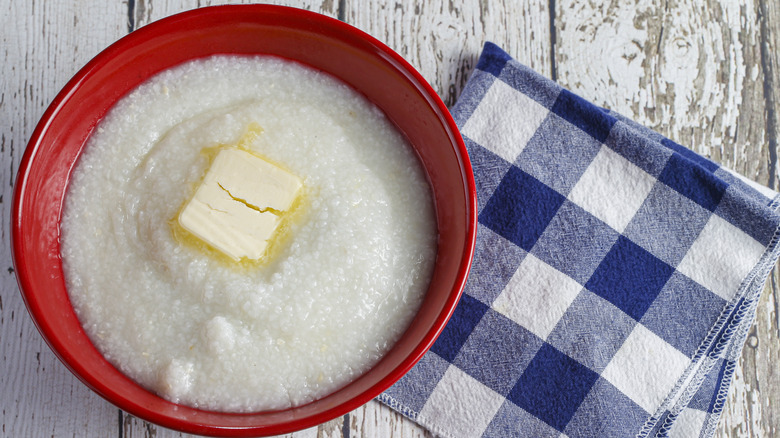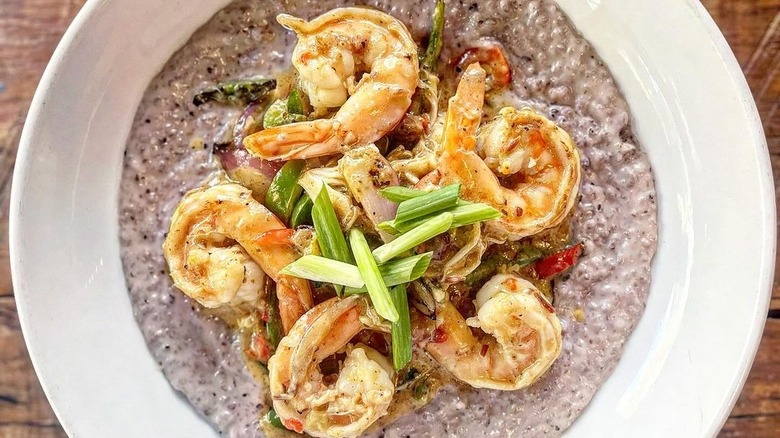Skip The Pantry When It Comes To Storing Grits
Sometimes the best place for a pantry staple is actually the freezer. That's certainly true for raw grits, which are made from milled dent corn, a variety that's less sweet and starchier than the on-the-cob side. The stone-ground grit is prepared using whole dried kernels, or bran, which gives it texture but also makes it more vulnerable to turning rancid.
Unless you're moving through your bag very quickly — in which case, you can keep the bag in the fridge — you'll find that the light, moisture, and heat of your kitchen can make the ingredient spoil more quickly, grow mold, or even attract pests. Freezing the milled grain keeps it at peak freshness and gives you more time to work through your bag or box. Technically, you can keep the corn in your freezer for as long as you'd like, but you'll find it's at its best within the first six months of storage.
Before you stick your current open box in the cooler, it's worth giving your grits a once-over, just like you should probably check and see if your flour has expired. If you notice any off smells, you should start a fresh bag. Unopened bags can go directly into the deep freeze, but once you begin cooking, place the contents into an airtight container.
Types of grits to freeze
Stone-ground grits benefit most from being stored in the freezer, but it doesn't hurt to store your other pantry items in a cool, dry place. Other grits at the store are produced differently to ensure they last even longer, but there's still a chance unwanted critters or mold can sneak into the batch. Plus, lower temperatures will help protect any sweet aromas or flavors.
Finely ground, quick-cooking variety and pre-cooked instant grits don't contain the bran, which keeps them more shelf-stable but also means they contain less flavor and texture. And hominy grits are prepared using nixtamalized corn, which is corn soaked in a mixture of alkaline solution, lime, and water. Producers remove the volatile germ from this style, too, but, just like masa harina, you'll extend the shelf life by keeping it in a cool spot.
Technically, you can even freeze cooked grits. The prepared pantry staple holds up in cold conditions and is easy to defrost. Rather than popping the entire pot of porridge onto a shelf, consider portioning it into smaller servings for an easy-to-defrost side. And just like cornmeal, polenta, and grits are sometimes interchangeable, one thing is for sure — this storage tip applies across different types of ground corn.
Taste the grits rainbow
You might be surprised to find that stores are beginning to sell a rainbow of heirloom ground corn products, which can delight both the eyes and the palate as you taste the nuances of different species. Of course, the most common hues you'll see are yellow and white grits. The difference between the two is slight, but you'll find the sunny yellow ground is sweeter and its flavor is more pronounced.
But mills and farmers are also cultivating striking and nuanced red, pink, and blue corn grits. One variety, called "Jimmy Red," comes from a corn originally bred for whiskey production, and you'll find it's slightly sweeter than the run-of-the-mill white or even bright yellow. Another ruby red heirloom making waves is "Bloody Butcher," a rough name for a gentle corn formerly used in moonshine and beloved for its rich, nutty flavor.
Pink "unicorn" grits, milled pink and purple kernels, are notably creamy (and camera-friendly). Blue corn can offer more of a floral or savory note compared to its colorful counterparts and cooks into a blue or purple-toned porridge. For the brightest possible bowl, use acid to draw out the colors. We suggest testing out the move with a squeeze of lemon or lime to finish your batch of shrimp and grits.



